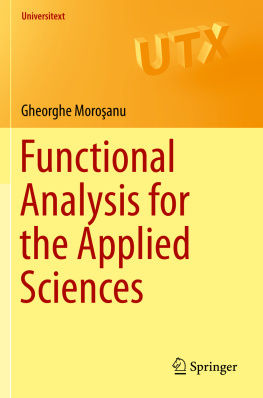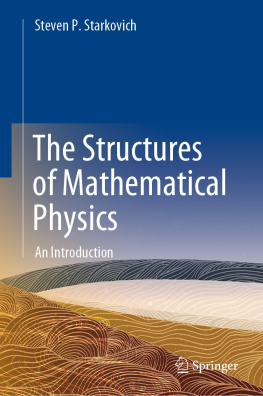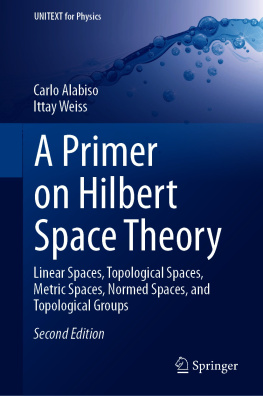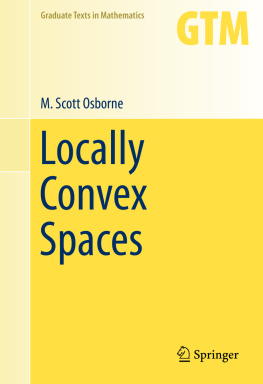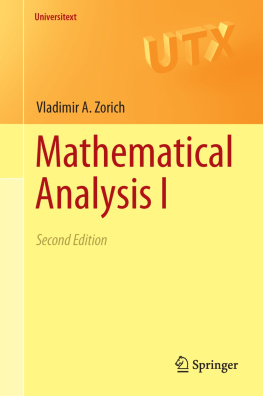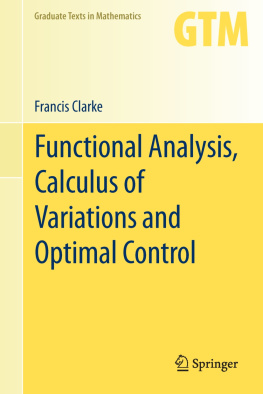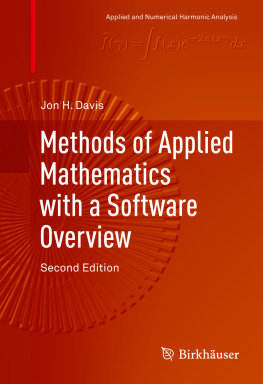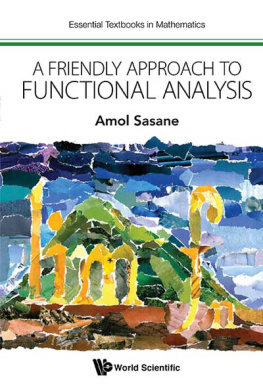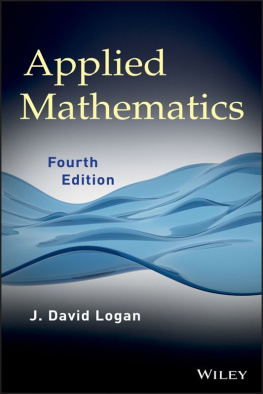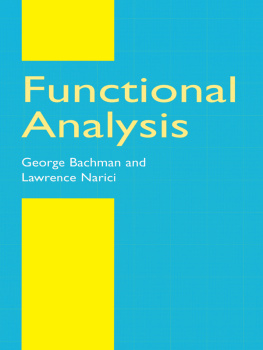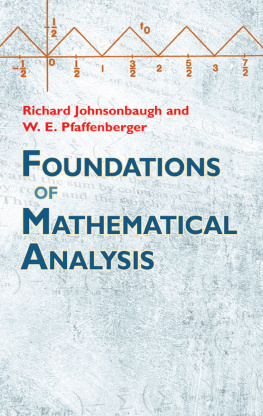Universitext
Series Editors
Sheldon Axler
San Francisco State University, San Francisco, CA, USA
Carles Casacuberta
Universitat de Barcelona, Barcelona, Spain
John Greenlees
University of Warwick, Coventry, UK
Angus MacIntyre
Queen Mary University of London, London, UK
Kenneth Ribet
University of California, Berkeley, CA, USA
Claude Sabbah
cole Polytechnique, CNRS, Universit Paris-Saclay, Palaiseau, France
Endre Sli
University of Oxford, Oxford, UK
Wojbor A. Woyczyski
Case Western Reserve University, Cleveland, OH, USA
Universitextis a series of textbooks that presents material from a wide variety of mathematical disciplines at masters level and beyond. The books, often well class-tested by their author, may have an informal, personal even experimental approach to their subject matter. Some of the most successful and established books in the series have evolved through several editions, always following the evolution of teaching curricula, into very polished texts.
Thus as research topics trickle down into graduate-level teaching, first textbooks written for new, cutting-edge courses may make their way intoUniversitext.
More information about this series at http://www.springer.com/series/223
Gheorghe Moroanu
Functional Analysis for the Applied Sciences
Gheorghe Moroanu
Romanian Academy of Sciences, Bucharest, Romania, Department of Mathematics, Babes-Bolyai University, Cluj-Napoca, Romania
ISSN 0172-5939 e-ISSN 2191-6675
Universitext
ISBN 978-3-030-27152-7 e-ISBN 978-3-030-27153-4
https://doi.org/10.1007/978-3-030-27153-4
Mathematics Subject Classication (2010): 32A70
Springer Nature Switzerland AG 2019
This work is subject to copyright. All rights are reserved by the Publisher, whether the whole or part of the material is concerned, specifically the rights of translation, reprinting, reuse of illustrations, recitation, broadcasting, reproduction on microfilms or in any other physical way, and transmission or information storage and retrieval, electronic adaptation, computer software, or by similar or dissimilar methodology now known or hereafter developed.
The use of general descriptive names, registered names, trademarks, service marks, etc. in this publication does not imply, even in the absence of a specific statement, that such names are exempt from the relevant protective laws and regulations and therefore free for general use.
The publisher, the authors and the editors are safe to assume that the advice and information in this book are believed to be true and accurate at the date of publication. Neither the publisher nor the authors or the editors give a warranty, expressed or implied, with respect to the material contained herein or for any errors or omissions that may have been made. The publisher remains neutral with regard to jurisdictional claims in published maps and institutional affiliations.
This Springer imprint is published by the registered company Springer Nature Switzerland AG.
The registered company address is: Gewerbestrasse 11, 6330 Cham, Switzerland
Dedicated to my wife, Carmen
Preface
The goal of this book is to present in a friendly manner some of the main results and techniques in Functional Analysis and use them to explore various areas in mathematics and its applications. Special attention is paid to creating appropriate frameworks towards solving different problems in the field of differential and integral equations. In fact, the flavor of this book is given by the fine interplay between the tools offered by Functional Analysis and some specific problems which are of interest in the Applied Sciences.
The table of contents of the book (see below) offers a fairly good description of the material. In contrast with other books in the field, we present in Chap.the real number system, describing the CantorMray model which is most appropriate for our purposes here. Indeed, it is based on a completion procedure, allowing the extension from rational numbers to real numbers. This procedure involves the concepts of limit and infinity that are specific to analysis. We consider the CantorMray construction as the corner stone of mathematical analysis, which is why we pay attention to this subject which is usually assumed well known.
In order to help the reader to understand the richness of ideas and methods offered by Functional Analysis, we have included a section of exercises at the end of each chapter. Some of these exercises supplement the theoretical material discussed in the corresponding chapter, while others are mathematical problems that are related to the real world. Some of the exercises are borrowed from other books, being reformulated and/or presented in a form adapted to the needs of the corresponding chapter. We do not indicate the books where individual exercises come from, but all those sources are included into the reference list of our book. In any event, we do not claim originality in such cases. Other exercises were invented by us to offer the reader enough
material to understand the theoretical part of the book and gain expertise in solving practical problems. In the last chapter of the book (Chap.), we provide solutions to almost all exercises. This is in contrast to many other books which include exercises without solutions. For easy exercises, we provide hints or final solutions, and answers to very easy exercises are left to the reader. I encourage everybody to spend some time working on an exercise before looking at its solution.
We shall refer to an exercise by indicating the chapter and exercise numbers (and not the section number). For example, Exercisein this case).
The book is addressed to graduate students and researchers in applied mathematics and neighboring fields of science.
I would like to thank the anonymous reviewers whose pertinent comments improved the initial version of the book.
Special thanks are due to a former American student of mine, Ivan Andrus, who wrote the first draft of the present book as lecture notes for my Functional Analysis lectures in 2010. He also carefully checked the final version of the book and suggested several minor changes.
I am also indebted to my former student Liviu Nicolaescu for reading the first part of the book and correcting some errors.
Last but not least, I would like to thank Mrs. Elizabeth Loew, Executive Editor at Springer, for our very kind cooperation that led to the successful completion of this book project.
Gheorghe Moroanu
Cluj-Napoca, Romania
Contents
1. Introduction
This chapter comprises definitions, notation, and basic results related to set theory, real and complex numbers, and linear spaces.
We assume that the reader is familiar with the basic concepts and results of set theory. However, we are going to recall or specify some concepts and symbols that will be frequently used in this book.

